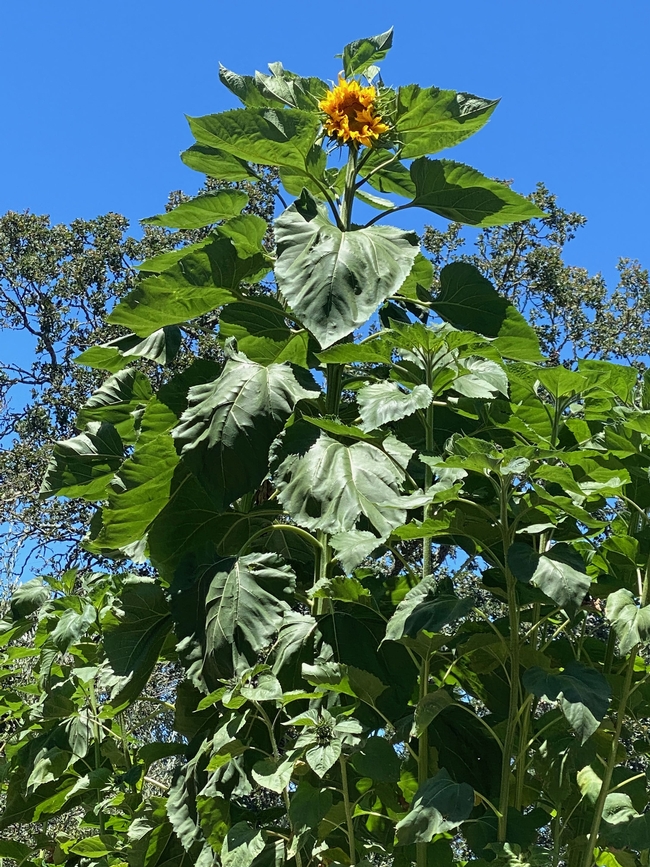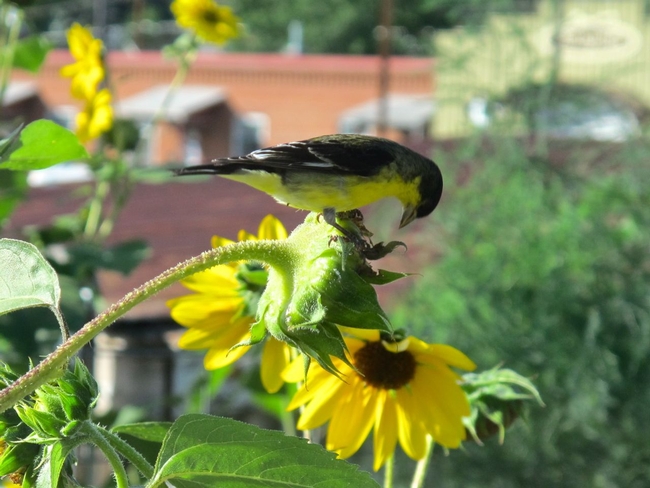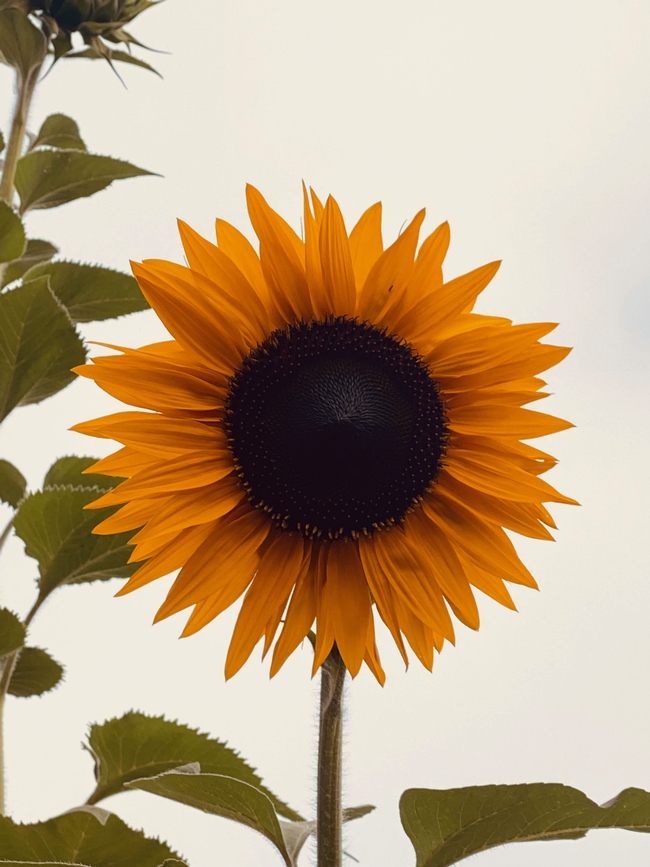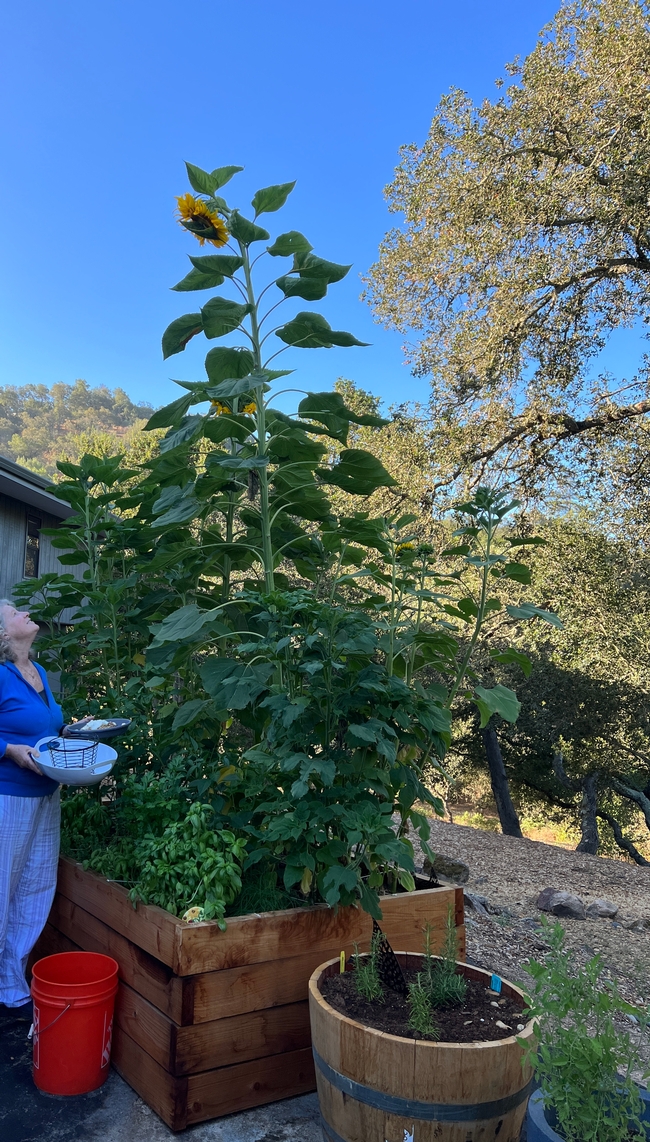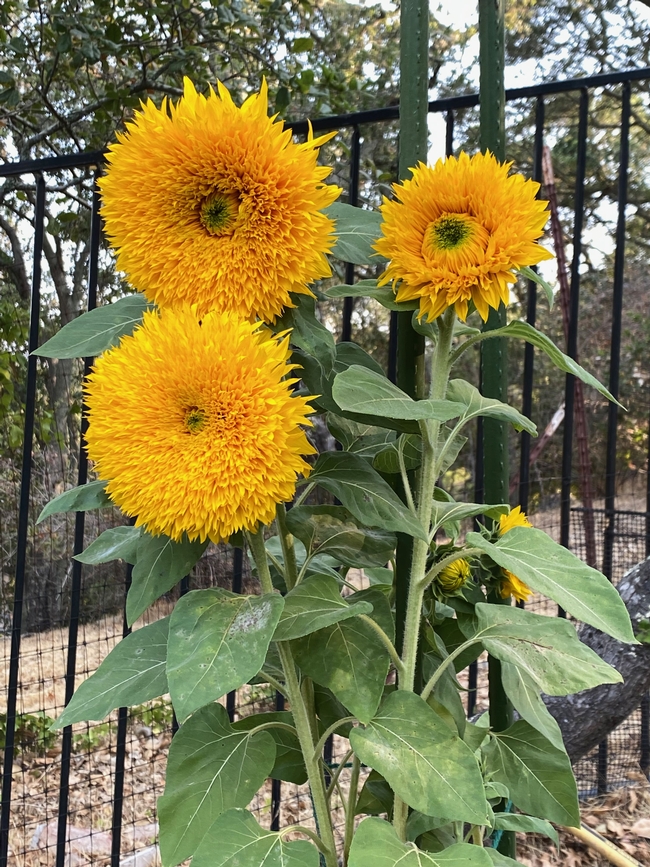About 25 years ago, my children and I planted a particularly exuberant flower garden in the backyard. We had pink and purple, and white cosmos, brilliant blue morning glories and many colors of zinnias. However, the star of the display was a stand of eight- to ten-foot tall sunflowers of the ‘Russian Mammoth' variety.
Their stalks were as thick as my daughter's arm, and the flower heads were so heavy I was afraid they would fall over, but they didn't. As the seeds in the center ripened, they became a feast for jays, finches, and chickadees. We got a great deal of pleasure out of those flowers, and the birds were ecstatic.
Sunflowers (Helianthus) are easy to grow. All you need is a patch of well-drained soil that gets several hours of sun a day. Compost is a good soil amendment. A little bit of chicken manure or other organic fertilizer when you plant the seeds is helpful, but after that, you won't need any.
The seeds should be planted an inch deep and kept damp for the first five weeks or so. After that, they need very little water, if any. Plant them after the last frost—in Napa, that is usually the beginning of April—and they will flower around July. You can see them all over the county now, adding color and cheer.
For something that is so easy to grow, sunflowers have an amazing visual effect. They are probably the most joyful plant in the entire landscape of home gardening and a satisfying entry-level project for young gardeners.
The center of the sunflower is made up of thousands of tiny florets—the real flowers of the plant. Each floret will become a seed.
If you want to harvest sunflower seeds, you will probably have to tie a thin cotton bag over the heads to keep the birds away. That is beyond my state of enterprise, however, especially when a sunflower is over six feet tall. Anyway, it's fun to see birds clinging to the flower head, gorging on seeds.
Sunflowers have been hybridized into all sorts of colors and sizes, from whites through yellows to dark red, and from two feet tall (‘Sundance Kid') to taller than most houses. ‘American Giant' can grow fifteen feet tall.
Consider the variety's full-grown height when planting your sunflower seeds. Sunflowers have a deep taproot, and large sunflowers need room. Three feet apart is not too much for the largest ones. Plant them at the back of your flower display so they don't shade other plants. You have greater placement latitude with the shorter varieties.
One thing I noticed about my giant sunflowers was that they turned their faces to meet the sun every morning. I had no idea why, and I hadn't noticed this habit on any other plant.
According to Dr. Stacy Harmer, a professor at U.C. Davis, sunflowers' heliocentrism, or focus on the sun, serves a purpose. Warmer flower heads attract more pollinators. She says that east-facing flowers have better reproductive success.
Harmer is running a study of sunflowers at Davis and has spoken about it to the Napa County Master Gardeners. Researchers at Davis are learning more about sunflowers each year. Harmer wants to find out how sunflowers can tell east from west even in the dark and how they time their movements so accurately. She calls them "clever plants" and they are.
Sunflowers originated in North America, where they were used for food and oil. European explorers took the seeds back home, and soon they were grown everywhere, from Russia to Italy. By the 17th century, sunflowers were appearing in Dutch paintings.
Other artists have found inspiration in this charismatic flower. Most of us are familiar with Van Gogh's sunflower paintings. Diego Rivera favored sunflowers in his work. So did Mary Cassatt. The English Aesthetic Movement practically made the sunflower its mascot, and it can be seen in all manner of fine and applied artworks of that period, including posters, portraits, furniture, and textiles.
Today many of us have seen the sunflower appearing as a patriotic symbol of Ukraine. Indeed, the "black oil" sunflower is an important crop for that country. (The black seeds contain more oil than the typical striped seed.)
The current war in Ukraine, along with drought and customer demand, has resulted in a shortage of sunflower oil. However, the bold and cheerful sunflower has come to symbolize resistance and hope. This optimistic flora deserves a place in our gardens.
Become a Master Gardener Volunteer! UC Master Gardeners of Napa County is now accepting applications for the Class of 2023. Click on the ”Join Us” button at napamg.ucanr.edu to read the informational brochure and register to attend a mandatory information session for applicants. Applications are due before 5 p.m. on September 30.
Workshop: UC Master Gardeners of Napa County will host a workshop on “Dealing with Heat and Less Water in the Garden” on Saturday, August 27, from 11 a.m. to 1 p.m., at Las Flores Learning Garden, 4300 Linda Vista Avenue, Napa. Learn about hot-weather plant care while still conserving water. Workshop is outdoors. Space is limited and registration required.
Library Talk: UC Master Gardeners will host a talk on “Lawn Alternatives” via Zoom on Thursday, September 1, from 7 pm to 8 pm. Learn about alternatives to lawn that will enrich your soil, attract pollinators and enhance the beauty of your yard. Register to receive the Zoom link.
Food Growing Forum: Join UC Master Gardeners of Napa County for a free forum on “Seed Saving” (and what else to do in the garden in August) on Sunday, August 14, from 3 pm to 4 pm, via Zoom. Register to receive the Zoom link: https://ucanr.edu/2022FoodForumAugust
Got Garden Questions? Contact our Help Desk. The team is working remotely so please submit your questions through our diagnosis form, sending any photos to mastergardeners@countyofnapa.org or leave a detailed message at 707- 253-4143. A Master Gardener will get back to you by phone or email. For more information visit https://napamg.ucanr.edu or find us on Facebook or Instagram, UC Master Gardeners of Napa County.
Attached Images:
